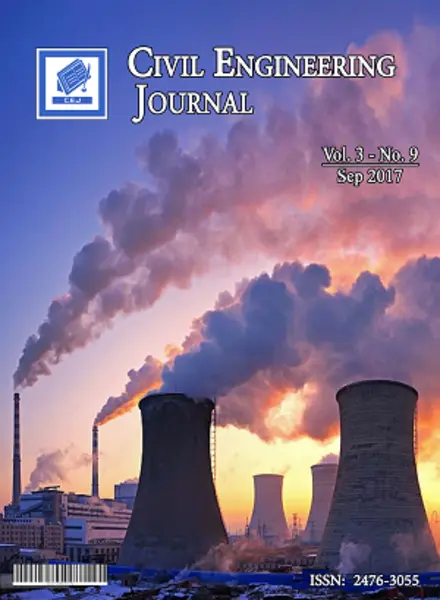-
flood analysis in karkheh river basin using stochastic model
جزئیات بیشتر مقاله- تاریخ ارائه: 1400/08/01
- تاریخ انتشار در تی پی بین: 1400/08/01
- تعداد بازدید: 687
- تعداد پرسش و پاسخ ها: 0
- شماره تماس ژورنال: 982188779475ext.258
this study analyzed the annual streamflow of karkheh river in karkheh river basin in the west of iran for flood forecasting using stochastic models. for this purpose, we collected annual stremflow (peak and maximum discharge) during the period from 1958 to 2015 in jelogir majin hydrometric station (upstream of karkheh dam reservoir). a time series model (stochastic model or arima) has three stages consists of: model identification, parameter estimation and diagnostic check. model identification was done by visual inspection on the autocorrelation and partial autocorrelation function. three types of arima(p,d,q) models (0,1,1), (1,1,1) and (4,1,1) suggested for the studied series. the suggested model parameters were computed using the maximum likelihood (ml), conditional least square (cls) and unconditional least square (uls) methods. in model verification, the chosen criterion for model parsimony was the akaike information criteria (aic) and the diagnostic checks include independence of residuals. the best arima model for this series was (4,1,1), with their aic values of 88.9 and 77.8 for annual peak and maximum streamflow respectively. forecast series up to a lead time of ten years future (2006 to 2015) were generated using the accepted arima models. model accuracy was checked by comparing the predicted and observation series by coefficient of determination (r2). results show that the arima model was adequate for the flood analysis in karkheh river and the forecast of the series in short time at future.
حوزه های تحت پوشش ژورنال
مقالات جدیدترین رویدادها
-
استفاده از تحلیل اهمیت-عملکرد در ارائه الگوی مدیریت خلاقیت سازمانی و ارائه راهکار جهت بهبود
-
بررسی تاثیر ارزش وجوه نقد مازاد بر ساختار سرمایه شرکت های پذیرفته شده در بورس اوراق بهادار تهران
-
بررسی تأثیر سطح افشای ریسک بر قرارداد بدهی شرکت های پذیرفته شده در بورس اوراق بهادار تهران
-
بررسی تأثیر رتبه بندی اعتباری مبتنی بر مدل امتیاز بازار نوظهور بر نقد شوندگی سهام با تأکید بر خصوصی سازی شرکت ها
-
تأثیر آمیخته بازاریابی پوشاک ایرانی بر تصویر ذهنی مشتری پوشاک ایرانی (هاکوپیان)
-
ارزیابی روش تحلیل استاتیکی غیرخطی مودی (mpa) در بررسی رفتار لرزه ای قاب های فولادی نیمه صلب با بادبند زانویی
-
بررسی تاثیر استفاده از کامپیوتر در آموزش دانش آموزان
-
ارزیابی گسترش مکانی و زمان شبیه سازی عددی ذرات آلاینده آب مبتنی بر معادله پخش انتشار (مورد مطالعه؛ بندر انزلی)
-
بررسی راهکارهای مختلف الگوسازی بزرگراه ها و ارایه دو راهکار هوشمند مدل سازی بر پایه ویونت
-
تاثیر شناخت الگوی دگردیسی محله بر پایداری کالبدی
مقالات جدیدترین ژورنال ها
-
مدیریت و بررسی افسردگی دانش آموزان دختر مقطع متوسطه دوم در دروان کرونا در شهرستان دزفول
-
مدیریت و بررسی خرد سیاسی در اندیشه ی فردوسی در ادب ایران
-
واکاوی و مدیریت توصیفی قلمدان(جاکلیدی)ضریح در موزه آستان قدس رضوی
-
بررسی تاثیر خلاقیت، دانش و انگیزه کارکنان بر پیشنهادات نوآورانه کارکنان ( مورد مطالعه: هتل های 3 و 4 ستاره استان کرمان)
-
بررسی تاثیر کیفیت سیستم های اطلاعاتی بر تصمیم گیری موفق در شرکتهای تولیدی استان اصفهان (مورد مطالعه: مدیران شرکتهای تولیدی استان اصفهان)
-
اثربخشی درمان مبتنی بر پذیرش و تعهد بر انعطاف پذیری، مهارت های خود مدیریتی و مهارت های تعاملی زنان خیانت دیده مراجعه کننده به مراکز مشاوره بهزیستی شهر اصفهان
-
تاثیر رفتار شهروندی سازمانی بر امنیت سیستم های اطلاعاتی (مطالعه موردی بانک توسعه تعاون)
-
بررسی و شناخت اقسام و ویژگی های المان های شهری
-
اتانازی و احتضار
-
جنبه های حقوقی مسئله رضایت به مداخله نظامی توسط دولت ثالث


سوال خود را در مورد این مقاله مطرح نمایید :